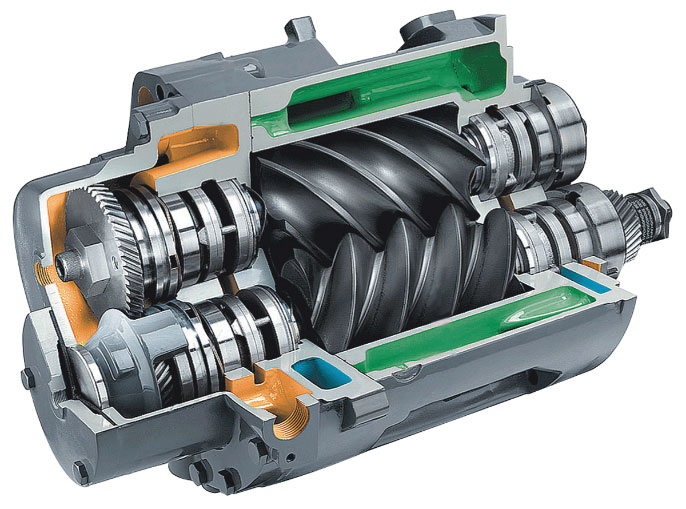Secrets for Refrigeration Compressor Lubrication
Compressors are very sensitive components that must be properly lubricated in order for them to achieve a long service life. The lubricant not only must be able to lubricate all the parts inside the compressor but also handle the refrigerant with which it is in contact (in the case of refrigeration and air-conditioning compressors). Some lubricants work better with certain refrigerants, and this must be balanced with the needs of the compressor in order to select the proper base oil and additive properties. By understanding how lubricants flow with refrigerants, as well as the requirements of the lubricant, you can ensure your compressors will run as efficiently and effectively as possible.
How Compressors Work
The function of a compressor is fairly simple. A gas enters the compressor at a low pressure, where it is compressed, and then leaves at a higher pressure. There are several byproducts to this compression, with the most common being heat and moisture. These byproducts are very detrimental not only to the health of the machine but also to the health of the lubricant.
While compressors can be used in a number of different applications, this article will focus primarily on compressors in refrigeration or heating, ventilation and air-conditioning (HVAC) systems. Within these applications, the refrigerant system is typically sealed and closed loop. The majority of these systems require the loop to be vacuumed prior to being charged with a refrigerant. By pulling these lines into a deep vacuum, the moisture inside the lines is boiled out and removed, keeping the system as dry as possible. This helps reduce the amount of water that is produced as a result of the compression process.
Compressor Types
 As with most machines, compressors come in a variety of types based on the application. Generally, the refrigerant or the required volume of cooling capacity will determine the kind of compressor that is needed. There are three main types of compressors used with refrigerants: reciprocating, rotary and centrifugal.
As with most machines, compressors come in a variety of types based on the application. Generally, the refrigerant or the required volume of cooling capacity will determine the kind of compressor that is needed. There are three main types of compressors used with refrigerants: reciprocating, rotary and centrifugal.
Reciprocating compressors function in a similar manner as a car engine. A piston slides back and forth in a cylinder, which draws in and compresses the low-pressure refrigerant, sending it downstream at a higher pressure. Frequently, reciprocating compressors are multiple-stage systems, which means that one cylinder’s discharge will lead into the input side of the next cylinder. This allows for more compression than a single stage. These compressors have many lubricated parts, such as cylinders, valves and bearings.
Rotary compressors normally use a set of screws or vanes to draw in the gas and compress it in the compression chamber. This could be compared to the function of a vane pump. Like reciprocating compressors, these systems have a variety of lubricated components, including gears, bearings, valves, etc.
Centrifugal compressors utilize the rotational motion of the drive to rotate a series of impellers, which will provide the compression action. These systems often are rotating at several thousand revolutions per minute. The lubricant must be thin enough to lubricate properly at these speeds but also thick enough to handle the heat and refrigerant contamination that can occur.
With all of these compressor systems, the lubricant’s base oil, additives and viscosity grade must be carefully selected. Compatibility with the refrigerant being compressed is perhaps the most important factor in choosing a base oil, as not all lubricants can handle this type of contamination. The additive package usually must have some anti-wear properties as well as demulsibility in the event of moisture contamination. The viscosity is variable depending on the load, speed and temperature at which the compressor will operate.
Understanding Refrigeration
Refrigeration has revolutionized many industries. Nearly every plant uses some sort of refrigeration, whether to help remove heat or simply for the comfort of the employees. How the cooling cycle works is quite simple. It involves the ideal gas law and how gases undergo a change in temperature when they are subjected to a change in pressure. The compressor acts as a pump to circulate the refrigerant. The refrigerant leaves the compressor as a high-pressure gas and moves into a condenser. Here, the gas is condensed into a liquid, which will then flow through a pipe until it reaches a metering device. This metering device is often referred to as a thermal expansion valve, piston or orifice. Basically, it necks down the opening in the line and causes a large pressure drop on the back side. As the pressure drops, so too does the refrigerant’s temperature.
Immediately after the metering device is the evaporator. This is where the heat transfer occurs. The air passing over the evaporator is warmer than desired. The heat in the air is absorbed by the refrigerant in the evaporator and then transported back to the condenser where it is removed. The compressor is what causes this movement.
Perhaps you’ve heard the expression that air conditioners or refrigerators don’t cool but actually move heat. This is exactly how the cycle works. Heat is moved from an area where it is not wanted to an area where it can be released. You can experience this effect on a hot summer day by walking to your outside air-conditioning unit (the condenser). The air coming out of the condenser’s top will be hotter than the ambient air.
Types of Refrigerants
Refrigerants must be able to absorb and transfer heat. There are several types of refrigerants, which are selected based on the desired temperature. Refrigerants must be able to readily change states from a liquid to a gas. This change of state is what allows for the sudden temperature drop after moving through the metering device. Depending on the refrigerant used, you can achieve very low temperature refrigeration or simply basic cooling capacity.
Perhaps the most prominent types of refrigerants are the hydrocarbon-based series. These are similar to what you would purchase for your house or car. They are often referred to by names such as R-22, R-134a, etc. Ammonia is another common refrigerant employed primarily in industrial facilities. It performs well and can achieve low temperatures for cooling or freezing. All told, there are dozens of different refrigerants composed of chlorofluorocarbons (CFC), hydrogen-containing CFC (HCFC), and hydrogen fluorine and carbon compounds (HFC), as well as combinations of each.
Compressor Lubricants
 Lubricants perform several functions in a compressor system. Of course, they must be able to lubricate the machine. In some systems, the lubricant is required to act as a cooling fluid as well as a sealant. This is why it’s important to select the proper lubricant for your compressor. When in doubt, check with the manufacturer about the correct oil for the system.
Lubricants perform several functions in a compressor system. Of course, they must be able to lubricate the machine. In some systems, the lubricant is required to act as a cooling fluid as well as a sealant. This is why it’s important to select the proper lubricant for your compressor. When in doubt, check with the manufacturer about the correct oil for the system.
Compressor lubricants are often a specialized blend of additives and base oils in order to provide the necessary lubricating properties while still being compatible with the refrigerant. Any incompatibility of the base oil and the refrigerant could have disastrous results for the equipment.
The majority of compressor lubricants are synthetic. This allows them to have a longer service life and handle the rigors of the system better than mineral-based fluids. Most home air conditioners now use a blended refrigerant known as R-410a. A polyolester (POE) base oil is employed to help lubricate the system, but this oil can also separate from the refrigerant.
Although the compatibility between the refrigerant and the lubricant is perhaps the most pressing issue in terms of lubrication, there are many others as well. For instance, moisture contamination can be very detrimental to some synthetic base oils that are hydrolytically unstable. Moisture reacts with the base oil to form acids, change the viscosity and impair the oil’s lubricating properties. This can lead to premature compressor failure as well as improper system cooling.
Lubricant problems are common in any system. One way to avoid having issues with the gases being compressed is to simply remove the lubricant from the equation. This is a frequent occurrence with the “dry” compressors becoming more widely used. “Dry” refers to the lack of oil in the compression chamber. If the lubricant is not in the compression chamber, it is much less likely to mix with the refrigerant and cause problems. However, in wet or flooded compressors, the oil is present in the compression chamber and mixes intimately with the refrigerant. In these systems, the lubricant’s compatibility with the refrigerant is paramount.
Many large compressors utilize a forced lubrication system, which features an oil reservoir, piping and a pump. The pump forces the oil through the piping and into the compressor where it lubricates and cools and then returns back to the reservoir. These systems enable you to filter, cool and separate gases and water from the oil while it is in service.
Smaller compressors typically are static-housed lubricant systems in which the compressor holds the oil and the system is completely sealed. Provided it is cleaned and sealed before being put into use, this type of system has a low likelihood of lubricant failure. Most often these systems will run for years without needing an oil change. The oil sits in the compressor to lubricate it, but some of the oil will flow through the refrigerant lines. In certain cases, an oil trap or knockout must be employed to keep oil from clogging the lines and reducing the system’s cooling capacity.
Oil Sampling
The History of Refrigeration
The refrigeration process dates back to the mid-1700s when experiments were conducted on how ice could be produced. The technology was perfected in the 1800s, and modern refrigeration was born. This allowed for the cooling or freezing of liquids and foods, which enabled them to be preserved longer. With some adaptation, these small refrigeration systems could be used to cool rooms in hospitals and homes to help the sick be more comfortable. This also had a huge impact on food and beverage companies, which previously had relied on tons of ice to provide the same cooling function.
In industrial plants, compressor systems tend to be among the most critical machines. Therefore, it is important to obtain oil samples periodically to check the health of the lubricant and the machine. Among the oil analysis tests performed on these fluids include elemental analysis, viscosity analysis and wear debris analysis. The viscosity must be monitored because refrigerant dilution can lead to a decrease in viscosity and an increase in machine wear.
In some cases, oil samples must be degassed before they can be shipped to the laboratory or analyzed. Since the gas expands with temperature, it can result in a pressure increase in the bottle, causing a leak or the oil to erupt upon opening the bottle. While pressure-relieving caps can be used with these bottles, remember that every time you open the bottle, you expose it to contamination, which can affect your particle count results.
With proper care and attention, the compressors in your refrigeration systems can provide years of trouble-free service. When changing the oil in these systems, keep in mind that it must be compatible with the refrigerant and the fluid previously used in the system. Finally, try to keep each compressor sealed, clean, cool and dry. If you are able to achieve this, you will stay cool even when the temperature outside gets hot.
